Related Research Articles

The almond is a species of tree native to Iran and surrounding countries, including the Levant. The almond is also the name of the edible and widely cultivated seed of this tree. Within the genus Prunus, it is classified with the peach in the subgenus Amygdalus, distinguished from the other subgenera by corrugations on the shell (endocarp) surrounding the seed.

Olive oil is a liquid fat obtained by pressing whole olives, the fruit of Olea europaea, a traditional tree crop of the Mediterranean Basin, and extracting the oil.

The olive, botanical name Olea europaea, meaning 'European olive' in Latin, is a species of small tree or shrub in the family Oleaceae, found traditionally in the Mediterranean Basin. When in shrub form, it is known as Olea europaea'Montra', dwarf olive, or little olive. The species is cultivated in all the countries of the Mediterranean, as well as in Australia, New Zealand, North and South America and South Africa. It is the type species for its genus, Olea. The tree and its fruit give their name to the Oleaceae plant family, which also includes species such as lilac, jasmine, forsythia, and the true ash tree.
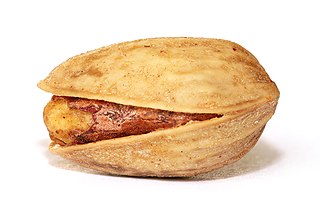
The pistachio, a member of the cashew family, is a small tree originating from an area that includes Afghanistan, Central Asia, and Iran. The tree produces seeds that are widely consumed as food.

A plum is a fruit of some species in Prunus subg. Prunus. Dried plums are most often called prunes, though after the year 2000 in the United States they may be just labeled as 'dried plums'.

The avocado is a medium-sized, evergreen tree in the laurel family (Lauraceae). It is native to the Americas and was first domesticated by Mesoamerican tribes more than 5,000 years ago. Then as now it was prized for its large and unusually oily fruit. The tree likely originated in the highlands bridging south-central Mexico and Guatemala. Its fruit, sometimes also referred to as an alligator or avocado pear, is botanically a large berry containing a single large seed. Avocado trees are partly self-pollinating, and are often propagated through grafting to maintain consistent fruit output. Avocados are presently cultivated in the tropical and Mediterranean climates of many countries. Mexico is the world's leading producer of avocados as of 2020, supplying nearly 30% of the global harvest in that year.
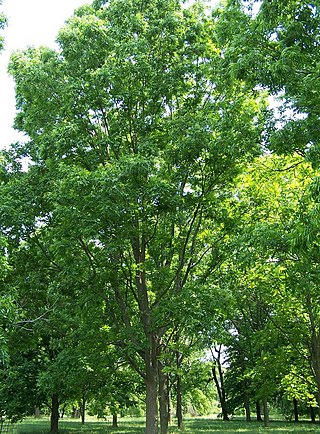
The pecan is a species of hickory native to the southern United States and northern Mexico in the region of the Mississippi River. The tree is cultivated for its seed primarily in the U.S. states of Georgia, New Mexico, and Texas, and in Mexico. The seed is an edible nut used as a snack and in various recipes, such as praline candy and pecan pie. The pecan is the state nut of Alabama, Arkansas, California, and Texas, and is also the state tree of Texas.
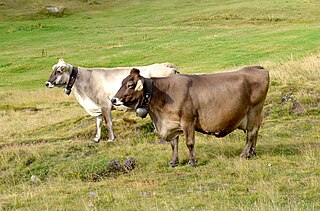
A breed is a specific group of domestic animals having homogeneous appearance (phenotype), homogeneous behavior, and/or other characteristics that distinguish it from other organisms of the same species. In literature, there exist several slightly deviating definitions. Breeds are formed through genetic isolation and either natural adaptation to the environment or selective breeding, or a combination of the two. Despite the centrality of the idea of "breeds" to animal husbandry and agriculture, no single, scientifically accepted definition of the term exists. A breed is therefore not an objective or biologically verifiable classification but is instead a term of art amongst groups of breeders who share a consensus around what qualities make some members of a given species members of a nameable subset.

Arbequina is a cultivar of olives. The fruit is highly aromatic, small, symmetrical and dark brown, with a rounded apex and a broad peduncular cavity. In Europe, it is mostly grown in Catalonia, Spain, but is also grown in Aragon and Andalusia, as well as California, Argentina, Chile, Australia and Azerbaijan. It has recently become one of the dominant olive cultivars in the world, largely under highly intensive, "super high-density" plantation.
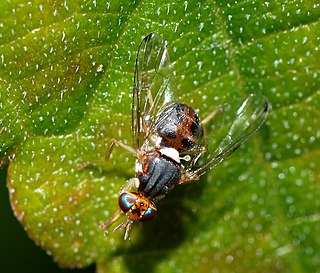
The olive fruit fly is a species of fruit fly which belongs to the subfamily Dacinae. It is a phytophagous species whose larvae feed on the fruit of olive trees, hence the common name. It is considered a serious pest in the cultivation of olives.

An orange is a fruit of various citrus species in the family Rutaceae ; it primarily refers to Citrus × sinensis, which is also called sweet orange, to distinguish it from the related Citrus × aurantium, referred to as bitter orange. The sweet orange reproduces asexually ; varieties of sweet orange arise through mutations.

The Bosana is the most common cultivar of olives in Sardinia. It makes up over 50% of the olive production on the island. The etymology of the name is uncertain, but it could refer to an alleged origin in the territory of Bosa. It is maintained, however, that the cultivar is of Spanish origin. It is used primarily for oil, but can also be eaten. The Bosana is a variety well adapted to less hospitable environments.

The Picholine is a French cultivar of olives. It is the most widely available cultivar in France. Though originally from Gard in southern France, it is today grown all over the world. The Picholine is best known as a cocktail olive, though it is also used to make olive oil. It is the most common variety of olive used for oil from Morocco.

The fig is the edible fruit of Ficus carica, a species of small tree in the flowering plant family Moraceae, native to the Mediterranean region, together with western and southern Asia. It has been cultivated since ancient times and is now widely grown throughout the world. Ficus carica is the type species of the genus Ficus, containing over 800 tropical and subtropical plant species.
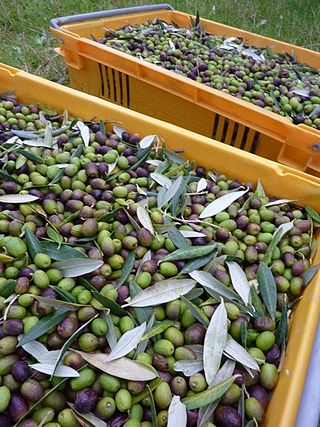
The Leccino olive is one of the primary olive cultivars used in the production of Italian olive oil. Across Italy, it is one of the primary olive cultivars found in olive groves. It is believed to have originated in Tuscany, and it is now grown all over the world. Due to its delicate flavor, the olive oil it produces is commonly blended with Frantoio, Coratina, Moraiolo and Pendolino in order to create more flavor.

Spilocaea oleaginea is a deuteromycete fungal plant pathogen, the cause of the disease olive peacock spot, also known as olive leaf spot and bird's eye spot. This plant disease commonly affects the leaves of olive trees worldwide. The disease affects trees throughout the growing season and can cause significant losses in yield. The disease causes blemishes on the fruit, delays ripening, and reduces the yield of oil. Defoliation and in severe cases, twig death, can occur, and the disease can have long-term health effects on the trees.

The Bidni, which is also referred to as Bitni, is an olive cultivar from the Mediterranean island of Malta. The fruit is small in size, hearty with a "violet colour", and is renowned for its superior oil which is low in acidity. The latter is generally attributed to the poor quality alkaline soil found on the Maltese Islands. As an indigenous olive cultivar, the Bidni has developed a unique DNA profile, and is believed to be among the most ancient species on the island, triggering local authorities to declare some of these ancient trees as "national monuments", and as having an "Antiquarian Importance", a status which is enjoyed by only a handful of other species.
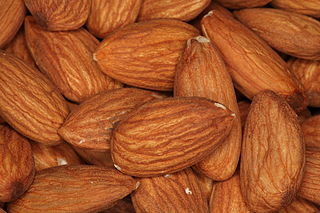
Agriculture is a significant sector in California's economy, producing nearly US$50 billion in revenue in 2018. There are more than 400 commodity crops grown across California, including a significant portion of all fruits, vegetables, and nuts for the United States. In 2017, there were 77,100 unique farms and ranches in the state, operating across 25.3 million acres of land. The average farm size was 328 acres (133 ha), significantly less than the average farm size in the U.S. of 444 acres (180 ha).

Manzanilla olives ("man-zah-nee-ya") or Manzanillo, also Manzanilla de Sevilla, originally from the area of Seville, Spain, are sometimes referred to as Spanish olives but along with Arbosana, Arbequina, Cacereña, Hojiblanca, Empeltre, and Gordal there are over two hundred varieties grown in Spain as well as other areas.
References
- 1 2 3 Scarafia, Liliana (18 October 2012). "Are Mission Olives Actually Picholine Marocaine?". The Olive Oil Times. Retrieved 25 February 2013.
- 1 2 "Ark of Taste: California Mission Olive". Slow Food USA . Retrieved 25 February 2013.
- ↑ "Mission Olive Oils - Olive Oil Guide". The Olive Oil Times. Archived from the original on 13 March 2013. Retrieved 25 February 2013.
- 1 2 Sutter, Ellen G. (1994). "Olive cultivars and propagation". In Ferguson, Louise; Sibbett, G. Steven; Martin, George C. (eds.). Olive Production Manual. Oakland, CA: University of California, Division of Agriculture and Natural Resources. p. 24. ISBN 1879906155. OCLC 30312488.
- ↑ Sutter, Ellen G. (1994). "Olive cultivars and propagation". In Ferguson, Louise; Sibbett, G. Steven; Martin, George C. (eds.). Olive Production Manual. Oakland, CA: University of California, Division of Agriculture and Natural Resources. p. 25. ISBN 1879906155. OCLC 30312488.
- ↑ Sutter, Ellen G. (1994). "Olive cultivars and propagation". In Ferguson, Louise; Sibbett, G. Steven; Martin, George C. (eds.). Olive Production Manual. Oakland, CA: University of California, Division of Agriculture and Natural Resources. p. 23. ISBN 1879906155. OCLC 30312488.
- 1 2 Connell, Joseph H. (1994). "History and scope of the olive industry". In Ferguson, Louise; Sibbett, G. Steven; Martin, George C. (eds.). Olive Production Manual. Oakland, CA: University of California, Division of Agriculture and Natural Resources. p. 3. ISBN 1879906155. OCLC 30312488.
- ↑ Connell, Joseph H. (1994). "History and scope of the olive industry". In Ferguson, Louise; Sibbett, G. Steven; Martin, George C. (eds.). Olive Production Manual. Oakland, CA: University of California, Division of Agriculture and Natural Resources. p. 7. ISBN 1879906155. OCLC 30312488.
- 1 2 Rosenblum, Mort (1996). Olives: The Life and Lore of a Noble Fruit. New York: Farrar, Straus and Giroux. p. 289. ISBN 0865475032. OCLC 34782656.
- ↑ Taylor, Judith M. (2000). The Olive in California: History of an Immigrant Tree . Berkeley, CA: Ten Speed Press. p. 104. ISBN 1580081312. OCLC 42619726.
- ↑ Connell, Joseph H. (1994). "History and scope of the olive industry". In Ferguson, Louise; Sibbett, G. Steven; Martin, George C. (eds.). Olive Production Manual. Oakland, CA: University of California, Division of Agriculture and Natural Resources. p. 6. ISBN 1879906155. OCLC 30312488.
- ↑ Taylor, Judith M. (2000). The Olive in California: History of an Immigrant Tree . Berkeley, CA: Ten Speed Press. p. 11. ISBN 1580081312. OCLC 42619726.
